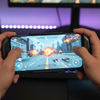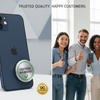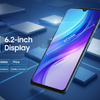A Look Back at Iconic Mobile Phones That Shaped the Industry
Introduction
The world of mobile phones has evolved significantly over the years, with each new advancement pushing the boundaries of what is possible. To truly appreciate the smartphones we have today, it is important to understand the history behind them. This includes recognizing the iconic mobile phones that shaped the industry and set the trends for future devices.
An iconic mobile phone is a device that not only introduced groundbreaking features but also left a lasting impact on the industry. These devices revolutionized how we communicate, work, and navigate through our daily lives. By examining the history of iconic mobile phones, we can gain insights into the technological advancements that have paved the way for our modern smartphones.
In the following sections, we will explore some of the most iconic mobile phones in history and delve into the innovations they brought to the table. From the first touchscreen to the introduction of cameras and gaming capabilities, these devices have shaped the way we perceive and use mobile phones.
Join us as we take a trip down memory lane and uncover the fascinating story behind these iconic mobile phones.
Transition to the First Section
But first, let's dive into the world of iconic mobile phones and explore the devices that have shaped the industry.
The First Smartphones
In the world of mobile phones, the first smartphones paved the way for the devices we have today. These iconic mobile phones introduced revolutionary features and set the trends for future advancements. Let's explore two of the first smartphones that shaped the industry.
IBM Simon: The First Phone with a Touch Screen
In 1992, the IBM Simon was launched as the first phone with a touch screen. Although the term "smartphone" was not coined at the time, the IBM Simon is considered the first smartphone. It featured a touchscreen display and was powered by the Symbian operating system.
One of the notable features of the IBM Simon was its use of a stylus for interacting with the touch screen. This innovative device marked a significant milestone in mobile phone technology and laid the foundation for future touch screen smartphones.
Ericsson 380: Combining PDA and Mobile Phone Features
Launched in the year 2000, the Ericsson 380 was marketed as the first smartphone. It boasted a combination of Personal Digital Assistant (PDA) and mobile phone features, making it a versatile device for its time.
The Ericsson 380 allowed users to access their PDA functions, such as calendars, address books, and task lists, while also providing the essential capabilities of a mobile phone. This convergence of features set the stage for the multifunctionality we now expect from our smartphones.
These first smartphones, the IBM Simon and the Ericsson 380, laid the foundation for the smartphones we use today. Their groundbreaking features and innovative designs paved the way for the advancements that have shaped the industry.
Transition to the Next Section
Now that we've explored the first smartphones, let's continue our journey through mobile phone history and discover more iconic devices that have left a lasting impact on the industry.
Groundbreaking Mobile Phones
In the world of mobile phones, there have been several iconic devices that have shaped the industry and set the trends for future advancements. Let's take a closer look at three of these groundbreaking mobile phones.
Motorola DynaTAC 8000x: The First Commercial Cell Phone
The Motorola DynaTAC 8000x is widely recognized as the first commercial cell phone. It was introduced in 1984 and marked a significant milestone in mobile phone technology. The DynaTAC 8000x had a hefty price tag of $3,995 at the time, making it a luxury item for early adopters.
Nokia 1100: The Best-Selling Phone in History
The Nokia 1100 holds the title for the best-selling phone in history, with sales of over 250 million units. This iconic device was released in 2003 and quickly gained popularity worldwide. Its simple design, durability, and affordability made it a favorite among consumers.
BlackBerry 850: The First BlackBerry Phone
The BlackBerry 850 was the first phone released under the BlackBerry brand. It made its debut on July 12, 1999, and was one of the first devices to allow users to connect to their corporate emails and contacts. The BlackBerry 850 had a range of features, including messaging, email functionality, a calendar, address book, calculator, and alarm function.
These groundbreaking mobile phones, the Motorola DynaTAC 8000x, Nokia 1100, and BlackBerry 850, each played a significant role in shaping the industry and setting the stage for future advancements.
Transition to the Next Section
Now that we've explored these iconic devices, let's continue our journey through mobile phone history and discover more groundbreaking phones that have left a lasting impact on the industry.
Innovative Phone Features
As mobile phones continued to evolve, new features were introduced that pushed the boundaries of what was possible. Let's explore some of the innovative phone features that have shaped the industry and transformed the way we use our smartphones.
Nokia N-Gage: Game Controller Layout
The Nokia N-Gage was a revolutionary phone that introduced the concept of a game controller layout. Released in 2003, it combined the functionality of a mobile phone with gaming capabilities, making it the perfect device for gaming enthusiasts on the go.
The Nokia N-Gage featured a unique design with a dedicated gamepad layout, allowing users to play their favorite games with ease. It also had a 2.1-inch display, a 104 MHz processor, and 3.4 megabytes of built-in memory. With its innovative design and gaming features, the Nokia N-Gage set the stage for future gaming smartphones.
HTC Dream: The First Android Phone
In 2008, the HTC Dream, also known as the T-Mobile G1, was released as the first phone to run on the Android operating system. This marked a significant milestone in the smartphone industry and paved the way for the widespread adoption of the Android OS.
The HTC Dream featured a 3.2-inch touchscreen display and a slide-out physical keyboard, providing users with both touch and typing capabilities. It also introduced features such as push email, Google Maps, and the ability to download apps from the Android Market.
iPhone: A Game-Changer in Smartphone Design
No discussion of innovative phone features would be complete without mentioning the iPhone. Released in 2007, the first iPhone revolutionized the smartphone industry with its sleek design and intuitive user interface.
The iPhone featured a 3.5-inch touchscreen display with a resolution of 320 by 480 pixels. It was powered by a 412 MHz processor and had a 2-megapixel camera. The device came in three storage options: 4GB, 8GB, and 16GB.
One of the standout features of the iPhone was its multi-touch functionality, which allowed users to pinch, zoom, and swipe through content with ease. This intuitive interface set a new standard for smartphone design and influenced the development of future devices.
Revolutionary Camera Technology
The Nokia Lumia 920 was the first phone to introduce optical image stabilization (OIS) in its camera. Released in 2012, this iconic mobile phone showcased the significance of OIS in smartphone camera technology.
Optical image stabilization allows for sharper and less blurry photos by compensating for hand movements while taking pictures. This technology revolutionized smartphone photography, as it enabled users to capture clear and steady shots even in low-light conditions or while in motion.
In addition to its groundbreaking camera technology, the Nokia Lumia 920 also featured Windows Phone's liquid cooling technology. This innovation helped prevent the phone from overheating during heavy usage, ensuring optimal performance at all times.
The introduction of liquid cooling technology in the Nokia Lumia 950 and 950 XL further solidified its significance in the smartphone industry. This cooling solution allowed for more efficient heat dissipation, resulting in improved overall performance and longevity of the devices.
Currently, the Nokia 8 continues to utilize liquid cooling technology, offering users a smooth and reliable smartphone experience even during demanding tasks such as gaming or multitasking.
While the Nokia Lumia 920 brought OIS to the forefront, there is still debate about the first phone to feature a camera. Some argue that the Sharp J-SH04, released in Japan in 2000, was the first phone with a camera, as it allowed users to take photos electronically. However, others believe that the Samsung SCH-V200, also released in 2000, holds this title, as it featured a camera that required connecting to a computer to access the photos.
Regardless of the first phone to feature a camera, there is no denying the impact that camera technology has had on iconic mobile phones. From the Nokia Lumia 920's OIS to the ongoing advancements in smartphone cameras, these innovations have transformed how we capture and share our memories.
As technology continues to evolve, we can expect further enhancements in smartphone camera capabilities, pushing the boundaries of what is possible in mobile photography.
Conclusion
In conclusion, we have explored a variety of iconic mobile phones that have shaped the industry and set the trends for future advancements. From the first touchscreen phone, the IBM Simon, to the introduction of game controllers on phones with the Nokia N-Gage, these devices have revolutionized how we communicate and interact with our mobile phones.
It is important to recognize the contributions of these iconic mobile phones to the industry. They have paved the way for the smartphones we use today, with their groundbreaking features and innovative designs. By understanding the history behind these devices, we can gain insights into the technological advancements that have transformed our mobile phones.
We encourage you to share your thoughts on these iconic mobile phones in the comments. Did you own any of these devices? Which features do you think have had the biggest impact on the industry? We would love to hear your experiences and opinions.
Don't forget to like and share this blog to spread the knowledge about these iconic mobile phones. Help others discover the fascinating story behind these devices and their contributions to the industry.
FAQ
Here are some frequently asked questions about iconic mobile phones:
Can you provide more examples of iconic mobile phones?
Some other examples of iconic mobile phones include the Motorola DynaTAC 8000x, Nokia 1100, and BlackBerry 850. These devices have made significant contributions to the industry and have left a lasting impact on smartphone technology.
Are there any other significant features or innovations in smartphones?
Apart from the ones mentioned in the blog, there have been numerous other significant features and innovations in smartphones. Some of these include waterproofing, facial recognition technology, wireless charging, and augmented reality capabilities.
Were there any challenges faced during the development of these phones?
Yes, there were certainly challenges faced during the development of these phones. Some of the challenges included technological limitations, battery life, and the need to create user-friendly interfaces. Overcoming these challenges required extensive research and development efforts.
How have mobile phones evolved over time?
Mobile phones have evolved significantly over time. They have become smaller, more powerful, and more versatile. The introduction of touchscreens, cameras, internet connectivity, and app stores has transformed mobile phones into the multifunctional devices we use today.
What can we expect from future mobile phone technology?
Future mobile phone technology is expected to continue pushing the boundaries of what is possible. We can expect advancements in areas such as artificial intelligence, 5G connectivity, foldable displays, and enhanced camera capabilities. Additionally, there will likely be further integration with other smart devices and advancements in biometric security features.





